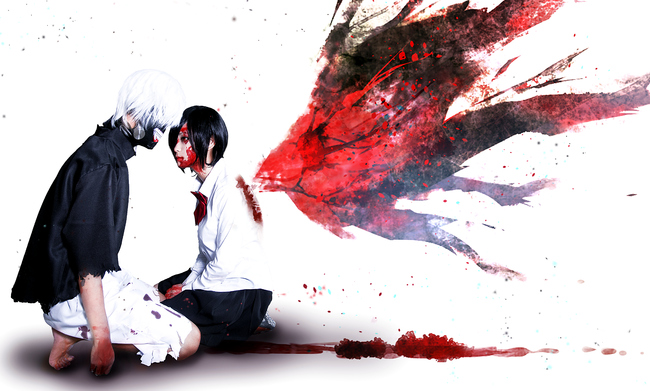Tokyo Ghoul don’t necessarily differentiate between different people in much the same way some people don’t see a difference between one chicken and the rest if they’re going to eat them, and this is likely to cause more problems for Ken in the ghoul community than anything else. Touka seems like she may be an exception to this rule, recognizing Ken and Hide from the café and taking an interest in Ken’s problems, and it seems likely that there are two factions of ghouls based on their opinions of humans. How Ken reconciles his human past with his half-ghoul present and future is thus far the most interesting aspect of the book, giving it an edge over other horror stories.

The titular ghouls aren’t fully explained in this volume, but from what we do learn, they appear to be a separate species who very closely resemble humans. Ghouls’ eyes turn red when they are hungry, but apart from that they could be anyone. This enables them to hunt their human prey with ease, as well as to keep a low enough profile that people still aren’t entirely positive that they exist, although the theory is gaining ground with each strange new murder discovered.

Ken isn’t sure he’s a believer, no matter how odd he and his friend find it that a beautiful girl asks him out. Ken‘s too thrilled to really question the situation, and he assumes that their shared love of an author is enough to merit their date. Unfortunately for him, the girl turns out to be a ghoul with plans of eating him, and only an accident saves him from that fate…even though he’s already mortally wounded. Both Ken and the ghoul are brought to a hospital, where, unaware that she’s not really human, the doctor uses her organs to save his life.

Now Ken is part ghoul with the attendant cravings for human flesh but with the moral qualms of a human being. He can’t eat without feeling like a cannibal, but other ghouls he meets, specifically Touka, who works at his favorite coffee shop, don’t want to let him abstain from it. Ken is caught between two worlds, unable to be fully part of either of them and not sure that he even wants to try.

That is not to say that the horror elements aren’t well-done. While Tokyo Ghoul isn’t as violent and bloody as it could be (as reflected by its T+ rating), there are still plenty of moments of visceral terror, and by and large the scenes of ghouls revealing themselves and hunting humans are well done. Fight scenes are not quite as dynamic as they could be, with Ishida using a few too many speed lines and blurs to make the art work as well as it might have, but the distorted faces and bodies still are quite effective. Ishida’s art is at its best when he’s being subtle – the use of black bordered pages for most of the ghoul scenes, for example, or when Ken remembers his friendship with Hide towards the end of the volume. Small background details are also worth paying attention to, as they can provide clues to a character.

Covering roughly the first two episodes of the anime, Tokyo Ghoul’s first volume sets up an interesting, intriguing world where the line between who is human and who is not is beginning to blur. Only Ken gets any real character development and the analogy between him and the book he is reading (about a murderer’s son) is a bit heavy-handed, but there is a lot of promise here. It can be a little gross, but if you like your horror to have a brain and a heart, this looks to be a good series to pick up.


More related posts:
The Inuyasha Thing You Don’t Want to Miss
